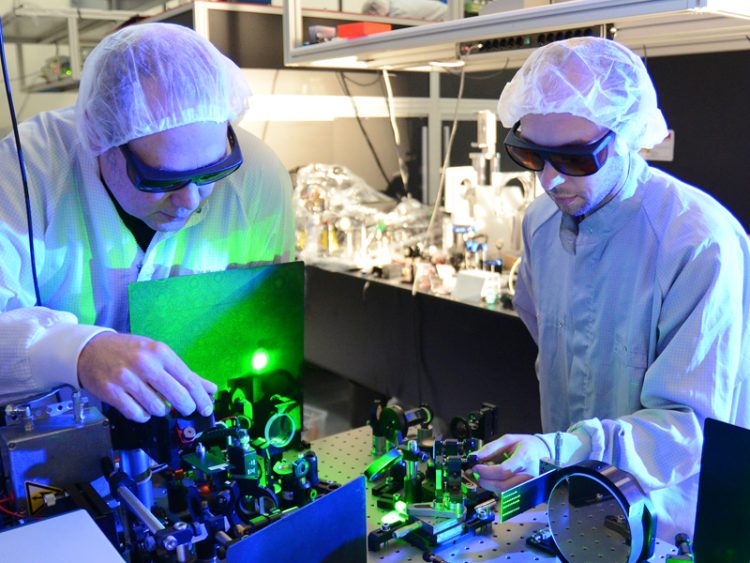Laser-based X-ray Imaging Picks Up Speed

The further development of ATLAS, the high-performance laser in LMU’s Laboratory for Extreme Photonics, paved the way for the tomographic reconstruction of the three-dimensional fine structure of a bone sample within a few minutes. (Photo: Thorsten Naeser)
Researchers from Ludwig-Maximilians-Universität (LMU), the Max Planck Institute of Quantum Optics (MPQ) and the Technical University of Munich (TUM) have taken a major step towards the clinical application of a new laser-based source of X-rays.
They recently demonstrated that the instrument enables the tomographic reconstruction of the three-dimensional fine structure of a bone sample within a few minutes. Up to now, laser-based measurements of this sort took several hours.
The breakthrough was made possible by the further development of ATLAS, the high-performance laser in LMU’s Laboratory for Extreme Photonics (LEX Photonics) der LMU on the Research Campus in Garching. Reconstruction of the sample from the imaging data was also facilitated by the use of specially designed computer programmes.
The X-rays used for medical imaging or to inspect the contents of passengers’ baggage at airports are produced by X-ray tubes, whose design has remained essentially unchanged for over a century. Research scientists prefer to use what is known as synchrotron radiation as an X-ray source.
Synchrotron radiation is many times brighter and thus allows one to carry out far more detailed structural analyses. However, sources of synchrotron radiation are relatively thin on the ground, as its generation requires the acceleration of electrons to ultrarelativistic velocities (speeds approaching that of light), and construction of particle accelerators of the necessary size is immensely costly.
To harness the advantages of synchrotron radiation for general use in medicine, physicists at LMU, the MPQ and the TUM have been exploring the application of high-performance lasers to the production of X-rays. In their set-up, hydrogen atoms are irradiated with extremely intense pulses of laser light. The highly energetic optical fields strip the electrons from the atoms and part of the ionized plasma electrons are accelerated.
Simultaneously, these electrons oscillate in the plasma fields, which causes them to emit the desired synchrotron radiation, i.e. high-intensity X-rays. Moreover, this whole process takes place over a path-length of less than 15 mm. So laser-based X-ray sources have a far smaller footprint, and are much less expensive to build, than conventional synchrotrons, but produce X-radiation of comparable quality.
In the early trials carried out at the Max Planck Institute in 2015, the research team was able to derive the three-dimensional structure of an insect from two-dimensional projection images taken from different angles. For the latest experiments, performed in the Laboratory for Extreme Photonics, Prof. Stefan Karsch and his colleagues have boosted the pulse rate, photon yield and photon energies, and this time they chose to image a sample of human bone. Thanks to an improved processing algorithm, developed by Prof. Franz Pfeiffer and his group at the TUM, the team needed to collect significantly less data than before. Accordingly, the complete tomogram could be obtained within less than three minutes.
The project was conceived and initiated in the Munich-Centre for Advanced Photonics (a Cluster of Excellence) and is undergoing further development at the Center for Advanced Laser Applications (CALA) in Garching. The laser systems available at CALA are expected to significantly enhance the efficiency of the source and the quality of the radiation generated, thus making this new form of tomography available for clinical applications for the first time. Thorsten Naeser
Figure caption:
The further development of ATLAS, the high-performance laser in LMU’s Laboratory for Extreme Photonics, paved the way for the tomographic reconstruction of the three-dimensional fine structure of a bone sample within a few minutes. (Photo: Thorsten Naeser)
Original publications:
A.Döpp, L. Hehn, J. Götzfried, J. Wenz, M. Gilljohann, H. Ding, S. Schindler, F. Pfeiffer, and S. Karsch
Quick X-ray microtomography using a laser-driven betatron source
Optica Vol. 5, Issue 2, pp. 199-203 (2018) doi.org/10.1364/OPTICA.5.000199
J.Götzfried, A.Döpp, M.Gilljohann, H.Ding, S.Schindler, J.Wenz, L.Hehn, F.Pfeiffer, S.Karsch
Research towards high-repetition rate laser-driven X-ray sources for imaging applications
Nuclear Instruments and Methods A (2018), doi.org/10.1016/j.nima.2018.02.110
Contacts:
Dr. Andreas Döpp
Ludwig-Maximilians-Universität München
Chair of Experimental Physics-Laser Physics
85748 Garching, Germany
Phone: +49 (0)89 289 – 14170
E-mail: a.doepp@physik.uni-muenchen.de
Dr. Olivia Meyer-Streng
Press & Public Relations
Max Planck Institute of Quantum Optics
85748 Garching, Germany
Phone: +49 (0)89 / 32 905 – 213
E-mail: olivia.meyer-streng@mpq.mpg.de
Media Contact
More Information:
http://www.mpq.mpg.de/All latest news from the category: Physics and Astronomy
This area deals with the fundamental laws and building blocks of nature and how they interact, the properties and the behavior of matter, and research into space and time and their structures.
innovations-report provides in-depth reports and articles on subjects such as astrophysics, laser technologies, nuclear, quantum, particle and solid-state physics, nanotechnologies, planetary research and findings (Mars, Venus) and developments related to the Hubble Telescope.
Newest articles

Security vulnerability in browser interface
… allows computer access via graphics card. Researchers at Graz University of Technology were successful with three different side-channel attacks on graphics cards via the WebGPU browser interface. The attacks…

A closer look at mechanochemistry
Ferdi Schüth and his team at the Max Planck Institut für Kohlenforschung in Mülheim/Germany have been studying the phenomena of mechanochemistry for several years. But what actually happens at the…

Severe Vulnerabilities Discovered in Software to Protect Internet Routing
A research team from the National Research Center for Applied Cybersecurity ATHENE led by Prof. Dr. Haya Schulmann has uncovered 18 vulnerabilities in crucial software components of Resource Public Key…





















